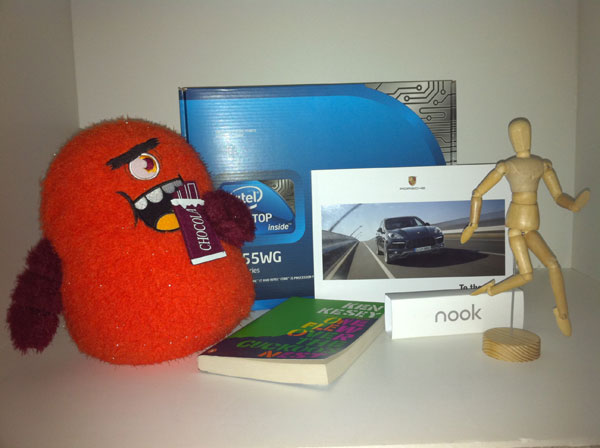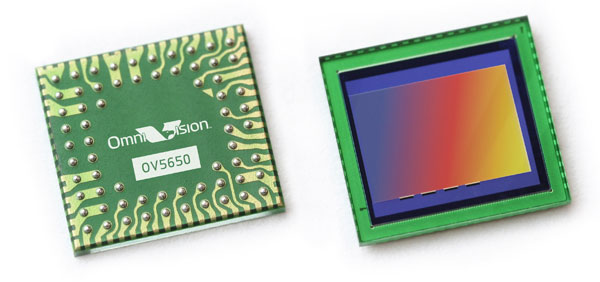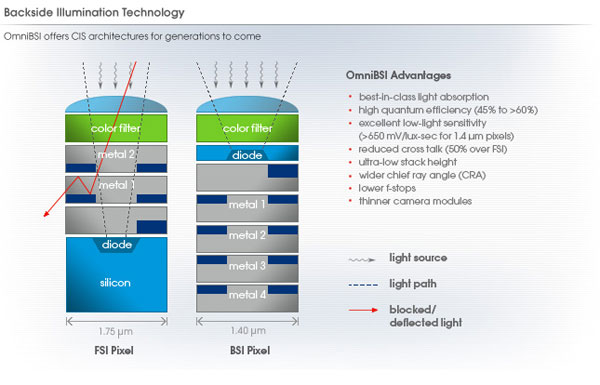Apple's iPhone 4: Thoroughly Reviewed
by Brian Klug & Anand Lal Shimpi on June 30, 2010 4:06 AM EST- Posted in
- Smartphones
- Apple
- iPhone 4
- Gadgets
- Mobile
Welcome to 2010, Apple Upgrades its Camera
The iPhone 4 is equipped with two cameras: a 5 megapixel camera with LED flash on the back of the phone and a VGA camera with no flash on the front. The LED flash works in both still and video modes. Like the EVO 4G, the iPhone 4‘s flash allows you to shoot in perfect darkness. If you’re filming a video in low light the LED will stay illuminated while you’re recording.

Taken with the iPhone 4 in total darkness
The same unfortunately can’t be said for the front facing camera on the 4. In anything but good lighting you’re going to get noise. It’s really only useful for FaceTime (or as an alternative to a mirror) and even then you need to be well lit for it to look decent.
Apple has opted for a 5 megapixel OmniVision sensor for the rear camera on the iPhone 4. What's interesting is that Apple has decided to bring backside illumination front and center with their marketing.
Backside illumination improves the sensitivity of CMOS and CCD detectors by reducing the amount of material in the path of incident light. In a frontside illuminated detector, a considerable amount of light is lost due to absorption that doesn't result in emission of an electron, in addition to reflection off pixel structures and electrical components near the frontside surface. Backside illumination greatly improves sensitivity by flipping the stack over. Instead of light having to pass through and possibly be reflected by metal structures, it is converted into electrons and read out by passing solely through silicon. Creating a backside illuminated part isn't as simple as flipping a sensor over, however, as manufacturers also generally thin the silicon light has to pass through before it can reach the photodiode. This further improves sensitivity and is generally accomplished through chemical etching in acid or by lapping (physically grinding) sensors at wafer scale.

OmniVision OV5650 - iPhone 4's rear camera SoC
Though backside illumination (BSI) improves quantum efficiency (how many photons are converted into electons), backside illumination is hugely important for another serious reason as well. Because the sensor is small at 4.6 mm by 3.4 mm, pixel size is also extremely small at just 1.75 microns square for the OV5650 in the iPhone 4 (state of the art sensors are 1.4 microns square, like those in the HTC Incredible's 8 MP sensor). Frontside illuminated parts generally have in the neighborhood of 10-15 microns of silicon before the active region of the photodiode where one wants photons to get converted to electrons. The result is that without backside illumination, pixels have a 10:1 ratio of height to length, you can visualize them as looking something like long square pillars. But that's a problem.
As photons are converted into electrons in that silicon, there's no guarantee that it will immediately travel down into the gate structure below to be read out by the camera. Electrons drift as they descend these columns, meaning that photons incident on one pixel don't necessarily map to the gate below. Because the smartphone camera sensors are so small, with a 10:1 ratio of height to size, the result is large amounts of so-called quantum blurring from electrons traveling into the gate structures of adjacent pixels. The result is a blurry image (and a decrease in MTF at the sensor level!), thus not representing the image that used to be incident on the sensor.
OmniVision and other smartphone CMOS sensor manufacturers thin that column down in an effort to come closer to having the pixel look more like a cube than a huge pillar. Ballpark numbers are between 3 and 6 microns, down from 10-15. The result is much more sensitive sensors that are higher resolution. While megapixels don't necessarily matter, neither does pixel size as much anymore; it's all about quantum efficiency, which is what engineers really care about.

OmniVision BSI - Courtesy OmniVision
The optical system of the iPhone 4 is difficult to characterize without disassembly, though the focal length is a bit shorter than previous iPhones. The result is that the photos are demonstrably wider angle. Backside illumination also allows for a bigger chief ray angle, higher numerical aperture (and thus lower f/#), but I won't bore you with the details.










270 Comments
View All Comments
JAS - Wednesday, June 30, 2010 - link
More information about the Microsoft Exchange patch is here:http://www.appleinsider.com/articles/10/06/30/appl...
campbbri - Wednesday, June 30, 2010 - link
Thanks for the review. I love that you intelligently think about the issues and aren't afraid to get into technical details. Too many reviews out there are boilerplate copies of each other, checking off boxes of features and impressions without trying to truly understand what is going on.jwwpua - Wednesday, June 30, 2010 - link
I have an iPhone 4 and while the battery life isn't bad, it does not seem nearly as good as I keep hearing. (It also arrived completely dead, even though it was manufactured the same week)Any chance you can provide the scripted web pages so I can compare my results with yours? Thanks, and great review!
vol7ron - Wednesday, June 30, 2010 - link
Am I one of the few that do the one-hand approach?Dominant hand to hold for tap, dominant thumb to tap/scroll/hold, dominant hand to hold to ear. :)
thekimbobjones - Thursday, July 1, 2010 - link
Maybe I could coat my hand in hard plastic film, instead of obscuring Apple's thoughtful industrial design with a bumper covering that stainless steel band of awesome.mealsonwheels - Thursday, July 1, 2010 - link
Great article! I pre-ordered my iPhone 4 through bestbuy so I didnt have to wait in any lines. I really like my phone but I'm having some serious antenna band issues! I really hope Apple addresses this by giving out free bumpers (similar to Wii giving out free grips) but i HIGHLY doubt Apple is going to do that. :(kreacher - Thursday, July 1, 2010 - link
The best iPhone review so far, especially the antenna issue.sporadic - Thursday, July 1, 2010 - link
I'm not finding the CPU to be the limiting factor, at least not at the speeds you were mentioning. Using the same speedtest app and a relatively dormant 10Mbit leased line I'm seeing access to the full bandwidth over wifi. In fact on the second run my transparent proxy kicked in and the download speed topped out at 17Mbit. It should be even faster from the cache but I suspect my structured wifi is likely to be the limiting factor.Screenshot here: http://yfrog.com/5bwebrop
damianrobertjones - Thursday, July 1, 2010 - link
Please now review the other phones in as much depth.Thanks
bplewis24 - Friday, July 2, 2010 - link
Not gonna happen. Remember there is a bias in play here.Brandon